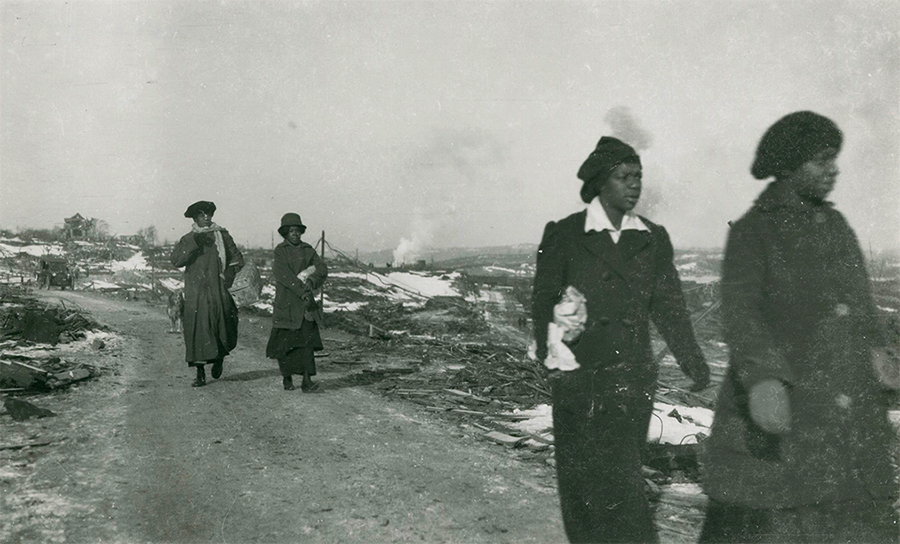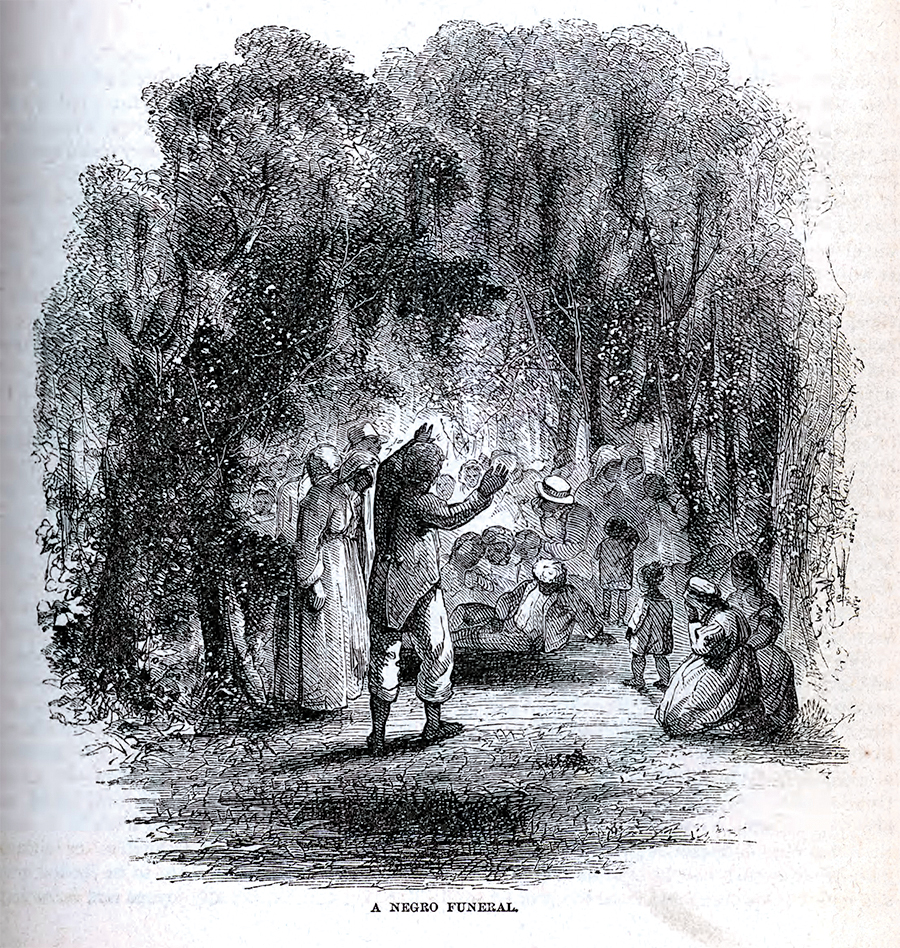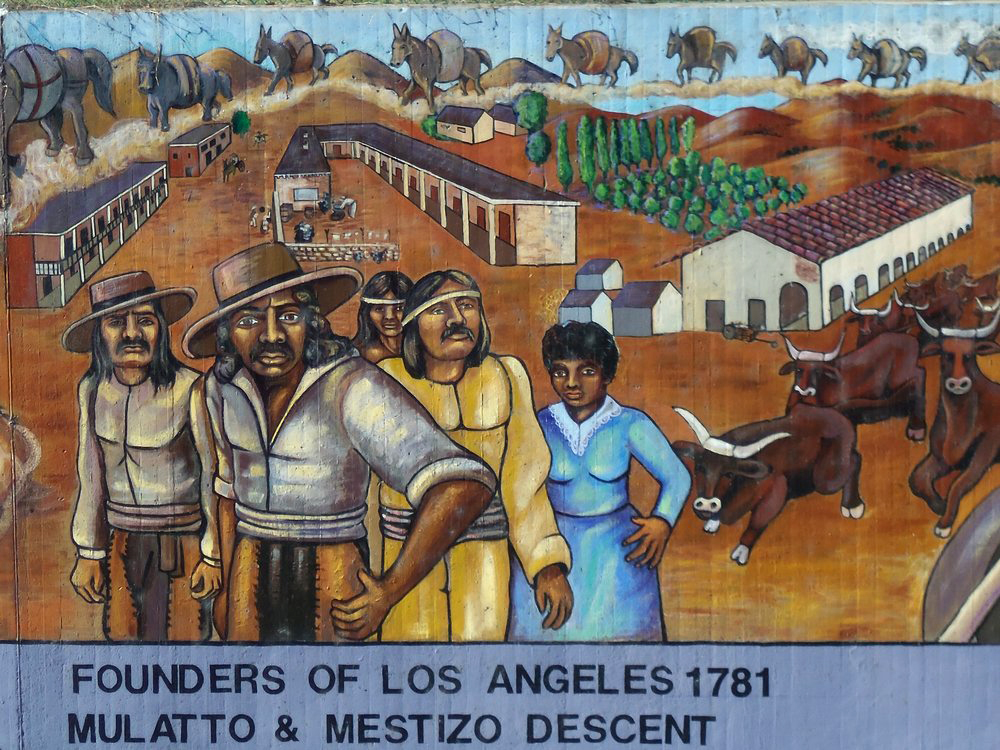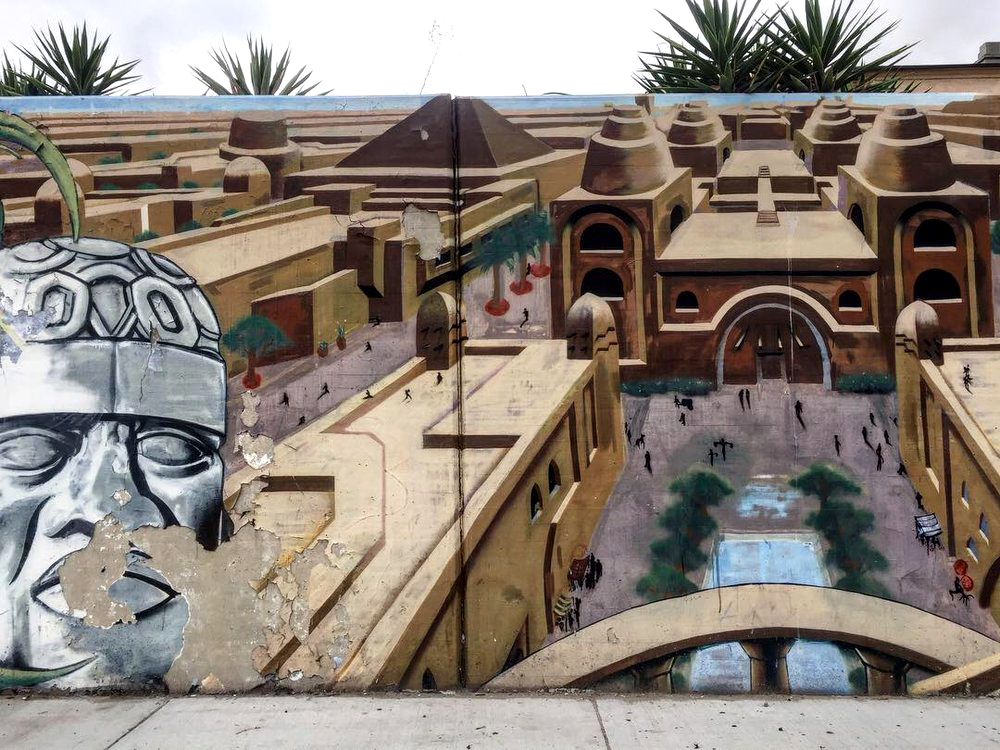Contested Memory
“Contested Memory” is an essay series I recently wrote for Monument Lab (see http://monumentlab.com/news/2019/2/24/the-rebel-archive). In the first two essays, I drew from a range of theorists and writers to examine how the historical record is constructed through active erasure and probed at the radical potential that imagination holds for charting black cartographies of freedom. I concluded the series with a third essay, turning to two murals in Los Angeles to demonstrate how counternarratives are embedded in everyday urban landscapes. The first and second essays are synthesized and condensed here, and the third is reproduced in full below.
Parts 1 and 2: Syncopation and the Cartographies of Freedom
In his pivotal work Silencing the Past: Power and the Production of History, late Haitian historian Michel-Rolph Trouillot drew from the buried histories of his homeland to demonstrate how power is exercised through the production of historical narratives.1 Trouillot focused his attention on the perceived impossibility of the Haitian Revolution. The uprising itself, he argued, was a direct affront to French and European conceptions of black humanity: that enslaved Africans could envision their own freedom and collectively rise up to overthrow a colonial government and create a new country was unthinkable, even among the European Left. Thus, the first successful slave revolt at a national scale was thinly referenced in the historical records of the moment, even as it unfolded, and it remains outside the frame of contemporary dominant discourse on the Age of Revolution. Trouillot linked that historical erasure to the ongoing exclusion and subordination of Haiti in world systems today. Events like the Haitian Revolution are not passively forgotten; they are actively silenced. Historical production occurs as events are transformed into facts, and it is through the creation, collection, interpretation, and resonance of these events-as-facts that power is exercised.
Across the Americas, the ongoing dispossession of black life by the state demands a distinct set of analytical tools for examining spatial erasure. As geographer Katherine McKittrick writes of Africville, the historic black community of Nova Scotia razed in the 1960s, commemorative gestures like historic markers inadequately challenge the white normativity of Canadian history.2 That Africville is continually heralded as the exception to that narrative — that it is nationally understood as the site where blackness was demolished, rather than as one contestation in an enduring struggle of emplacement — underscores what McKittrick deems the “absented presence” of black Canada.3 Scores of evidence, in the form of slave burial grounds, anti-black surveillance laws, unmistakable spatial names, such as N----- Rock* and Negro Creek Road, and the near total burning down of Montreal by an enslaved black woman named Marie-Joseph Angélique, disappear from the record through relocation, renaming, burying, and formalized forgetting.4 These acts of effacement all work in tandem with the continual constitution of Canadian blackness as recent, as urban, and as immigrant; histories suggesting otherwise represent an impossible disruption to the national narrative. To return to Trouillot, “the ultimate mark of power might be its invisibility; the ultimate challenge, the exposition of its roots.”5

James & Son, Women Walking from Africville towards Halifax, on Campbell Road near Hanover Street, 1917. Nova Scotia Archives Photo Collection.
If the histories that are documented in national archives and on marble monuments reflect the politics of their creation, then illuminating the fragments cut out of the narrative is itself a revelation. In his epic poem Cahier d’un retour au pays natal (Notebook of a Return to the Native Land), late Martinican writer Aimé Césaire framed historical documentation as a value-laden process.6 He wrote that for colonized people, narratives of place and ways of knowing would never be captured within colonial monumental projects:
At the end of the small hours these countries whose past is uninscribed on any stone, these roads without memory, these winds without a log.
Does that matter?
We shall speak. We shall sing. We shall shout.7
Colonization hinges on dispossession, and although the possessed aspects of black life regularly seeped into colonial records — what skills does this man hold? what is the price of that woman? — the souls of black folk have been silenced. Yet Césaire was writing at the dawn of Martinique’s decolonization, when subjects became citizens, so his observations pushed beyond the absenting of blackness from historical narratives. His was a revisionist call, to reclaim that which was obscured in the past; and yet, perhaps more importantly, he suggests that the collective voices of emergent decolonized nations in fact join a chorus that was already present. We were always speaking, singing, shouting, regardless of whether there is any evidence of it at all. And as McKittrick reminds us, “the profoundly disturbing nowhere of black life, in fact, provides a template to imagine the production of space not through patriarchal and colonial project trappings . . . [but as] an outlook that is structured by, but not beholden to, crass positivist geographies.”8 Territories of black life have never been readily reflected on the maps of states developed through black dispossession. Knowing this, scholars thinking through the framework of black geographies are advancing alternative ways of imagining space, rooted in the promise and project of collective liberation.9
Beyond the field of geography, three writers working in very different traditions offer meaningful examples of the power of radical imaginaries to probe at the unknowable spatial histories of people stripped of their humanity. In Lose Your Mother, American writer Saidiya Hartman traces her own travels back across the Atlantic in search of the unrecoverable, charting the disruptions of collective black life in the wake of the Atlantic slave trade.10 While her work offers no easy answers, she concludes the book with a discussion of Gwolu, a town in northwestern Ghana founded by people who came together in the nineteenth century in search of refuge from slave raiders. For Hartman, Gwolu is not a recovery of lost roots; rather, it is the site where she recognizes shared legacies of fugitivity and dreams of freedom.

“A Negro Funeral.” Harper’s New Monthly Magazine, 1859. Published in Camp 2004. Original caption: “It was in the remote spaces in the woods bordering plantations that enslaved people gathered for funerals, religious services, and secret, secular parties.” Library Company of Philadelphia.
In her groundbreaking work Closer to Freedom: Enslaved Women and Everyday Resistance in the Plantation South, late historian Stephanie Camp mined fragments in the archives to construct a spatial history of practices that enslaved people developed within the confines of antebellum plantation life.11 Drawing from postcolonial theorist Edward Said’s concept of rival geographies, Camp demonstrated how enslaved people manipulated their knowledges of plantation landscapes, cultivated through a lifetime of place-based bondage, toward the cause of freedom. Whether they assisted freedom seekers by providing them with shelter or came together at the plantation’s edges for gatherings at nightfall, enslaved people utilized their spatial knowledge to destabilize the efficacy of plantation order and create new forms of freedom. This rival geography offered enslaved people “alternative ways of knowing and using plantation and southern space that conflicted with planters’ ideals and demands.”12
Similarly, the rival geographies of plantation life are vividly imagined in The Known World, a novel by Edward P. Jones.13 In this work, the contested territories of a fictional Virginia county are richly depicted through the nighttime wanderings of Alice, an enslaved woman who is presumed by all to have lost her mind. Regularly leaving her cabin in the darkness of night, she crosses the threshold of the Townsend Plantation and sets out along the roads that lie beyond. Though these walks are regarded as the harmless acts of a senseless woman, these strategic meanderings enable her to survive encounters with patrollers that leave others assaulted or worse, while obscuring her ultimate goal of charting a path to freedom. These spatial transgressions lead to her liberation, and the novel concludes some years after her successful escape.
Even as structures of power limit recognition of territorial claims to propertied classes, understanding rival geographies reveals that different ways of knowing space are always already underway. Hartman’s expansive search for the past, Camp’s close reading of archival fragments, and Jones’s historical fiction all create ways of imagining and mapping the unrecoverable. When we try to make sense of the past, we turn to records, and yet records are not neutral. Where the records stop — where the stories are silenced — the work begins.

Panels from The Great Wall of Los Angeles. Photos by Hilary Malson, 2019, and Kaelyn Rodriguez, 2015.
Part 3: The Rebel Archive
Contestations over collective memory extend far beyond recognizing absences and doing imaginative work. Counternarratives are embedded all around us; our work, then, is to recognize, amplify, and support that praxis.
“Los Angeles is a city of conquest,” historian Kelly Lytle Hernandez writes in her most recent book, City of Inmates.14 In attempting to trace how Los Angeles came to be the incarceration capital of the nation, she was confronted with a research dilemma: how could she examine the history of incarceration in a city whose policing institutions had systematically destroyed their own records for decades?
Her methodological intervention, the “rebel archive,” suggests a way forward. In trying to uncover the history of mass incarceration in Los Angeles, she turned to “the words and deeds of dissidents,” whose far-flung records documented more than a century of resistance to human caging.15 She weaved together the scattered fragments of evidence, which ranged from scribbled handwritten notes to congressional testimony. By looking through and beyond repositories maintained by the state, she expanded the scope of her evidence and critically analyzed different perspectives on a single social institution. Backed by extensive research that spanned two centuries, she presented a forceful argument: mass incarceration in Los Angeles is the outcome of the eliminatory logic of settler colonialism. Her conclusions ultimately rely on the ongoing struggles that targeted communities have sustained against a violent and repressive state.
Like Lytle Hernandez, muralist and scholar Judy Baca foregrounds conquest and struggle in her study of Los Angeles. The Great Wall of Los Angeles (see photos) is the product of the participatory efforts of more than four hundred local teenagers, who worked collectively over several years to create a visual narrative of the multicultural history of Los Angeles.16 Mounted on the retaining wall of a concrete channel in the San Fernando Valley, the mile-long mural was begun in 1976 and is thought to be one of the longest in the world. The panels are organized as a timeline, starting with the prehistoric era and then tracing the Native communities who have inhabited the land for millennia. Significantly, the muralists framed the colonial encounter dualistically: indigenous perspectives of colonial conquest appear adjacent to the myth of discovery. The mural subsequently follows this contrapuntal reading and is heralded today for its attention to the obscured dimensions of the city’s history: labor organizers and community activists appear alongside global icons, and histories of violence, including lynchings, housing discrimination, and mass deportations, are framed as events that shaped life in Los Angeles as significantly as the development of the film industry. The Great Wall, then, is a monument: not to silencing but to the power of subaltern narratives that are preserved and shared despite ongoing suppression and threats.
Kaelyn Rodriguez, a PhD candidate in Chicana/o Studies at UCLA, researched The Great Wall for her master’s thesis and supported its cleaning in 2015. In her research, she framed the participatory creation of the mural by the team of predominantly low-income teens of color as a monument in its own right. In an interview for this piece, Rodriguez observed that “Judy single-handedly organized this effort to work with youth who would have otherwise been a part of the juvenile justice system, because they were already on the road to incarceration. . . . She was able to convince other folks in the city and say, ‘instead of putting these kids in a detention facility, give them to me for the summer.’” As the teenagers worked together over multiple summers on the mural, Judy brought in historians, artists, dancers, and poets to work with them and teach them the history.
This collaborative ethos brought together people from very different backgrounds. As Rodriguez notes, “this was L.A. in the ’80s, when there was a lot of racial tension. But no one got stabbed on the project, you know; there might have been fights, but Judy was a force, and people respected her and the work. For me, that is part of the amazing legacy of this project — all of the people who participated in making the mural.” Not only did these four hundred Angelenos craft a larger-than-life counternarrative of the city, they continue to carry these histories and transform collective memory by sharing these stories with new generations.
The Great Wall is celebrated locally as a foun-dational corrective to whitewashed myths about the City of Angels, yet hundreds of such works of public art are scattered all over the city. Across town, Out Mighty Contribution tells a different story. The mural along a wall on Crenshaw Boulevard connects black struggles in the United States to African history, Afrofuturist dreams, and global black consciousness. While murals have adorned the Crenshaw Wall since the 1970s, Our Mighty Contribution was created in the early 2000s by RTN (Rocking the Nation), a collective of graffiti artists.17 Heroic figures like Frederick Douglass and Marcus Garvey are depicted alongside the pyramids of Kemet and soldiers of the US Colored Troops.
These icons of black history are not directly connected to this city, yet the mural is deeply embedded in place, for it monumentalizes South Central Los Angeles as the heart of black life in the city. The mural draws references from across time and space to assert Crenshaw’s role as a diasporic anchor. In a city whose black population has dropped precipitously since the 1990s, this is a bold territorial claim. Land claims in black American communities are continuously threatened by structural forces, ranging from eminent domain to eviction; as a result, argue sociologists Marcus Anthony Hunter and Zandria Robinson, black senses of place are at once rooted and mobile.18 For black people in search of community in Los Angeles, the references enshrined in Our Mighty Contribution unambiguously announce: welcome home, you’ve arrived.
Geographer Laura Pulido reminds us that “all living things that pass through a landscape leave a trace — an energy if you will — that inhabits the land. Just as individual trauma rests in the body, collective trauma rests in the land, even when it’s rarely visible and in the everyday landscape, due to our heavy investment in denial.”19 The state’s investment in denying and erasing its own violence is heavy indeed, but valuable records of the rebel archive lie all around us, if we know where to look.
Hilary Malson is an urban geography and planning scholar who studies race, space, community organizing, and community development. She draws from the fields of diaspora studies, public history, and Black geographies to research how Black communities create expansive regional geographies of everyday life. She is currently a PhD student in urban planning at UCLA, a graduate researcher with Monument Lab, and a Ford Foundation predoctoral fellow, and was previously a curatorial research assistant at the Smithsonian Institution’s Anacostia Community Museum.
NOTES
- Michel-Rolph Trouillot, Silencing the Past: Power and the Production of History (Boston: Beacon Press, 1995 [2015]).
- Katherine McKittrick, Demonic Grounds: Black Women and the Cartographies of Struggle (Minneapolis: University of Minnesota Press, 2006).
- Ibid., 33.
- Afua Cooper, The Hanging of Angélique: The Untold Story of Canadian Slavery and the Burning of Old Montréal (Athens: University of Georgia Press, 2006).
- Trouillot, Silencing the Past, xxiii.
- Aimé Césaire, Return to My Native Land, trans. John Berger and Anna Bostock (Baltimore: Penguin Books, 1969).
- Ibid., 54.
- Katherine McKittrick, “Commentary: Worn Out,” Southeastern Geographer 57, no. 1 (2017): 96–100.
- American Association of Geographers, Black Geographies, 2018 AAG Theme, http://annualmeeting.aag.org/black_geographies, accessed 25 April 2019.
- Saidiya Hartman, Lose Your Mother: A Journey along the Atlantic Slave Route (New York: Macmillan, 2006).
- Stephanie Camp, Closer to Freedom: Enslaved Women and Everyday Resistance in the Plantation South (Chapel Hill: University of North Carolina Press, 2004).
- Ibid., 7.
- Edward P. Jones, The Known World (New York: Harper Collins, 2003).
- Kelly Lytle Hernandez, City of Inmates: Conquest, Rebellion, and the Rise of Human Caging in Los Angeles, 1771–1965 (Chapel Hill: University of North Carolina Press, 2017), 12.
- Ibid., 4.
- Judy Baca, “The Great Wall of Los Angeles,” 2019, http://www.judybaca.com/artist/portfolio/the-great-wall/, accessed 12 February 2019.
- Rocking the Nation, “Crenshaw Wall Restoration Project: Our Mighty Contribution,” 2014, http://ultrawav0.wixsite.com/crenshawwall/history, accessed 12 February 2019.
- Marcus Anthony Hunter and Zandria Robinson, Chocolate Cities: The Black Map of American Life (Oakland: University of California Press, 2018).
- Laura Pulido, “Landscapes of Racial Violence,” in LAtitudes: An Angeleno’s Atlas, ed. Patricia Wakida (Berkeley, CA: Heyday Books, 2015).
* This text was modified from the original printing for publication in this issue. Original text can be found at http://monumentlab.com/news/2019/2/24/the-rebel-archive.


